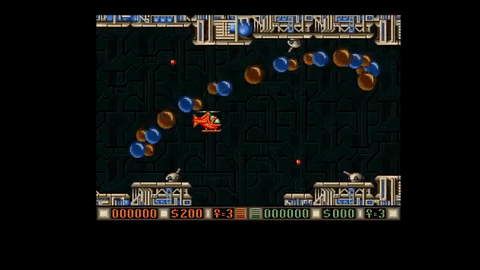Blood Money Amiga
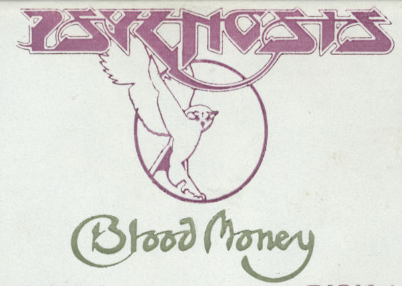 Published by
Published by
Psygnosis Limited
Developed by
DMA Design Limited
Released
1989
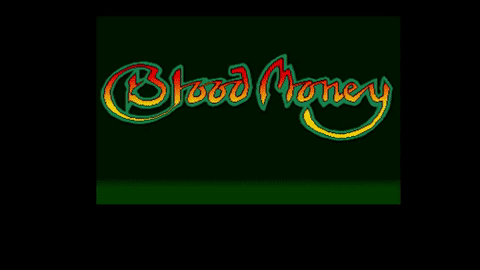
Blood Money
Have two words ever struck more terror into the heart of Amiga gamers?
Released in 1989 by Psygnosis and developed by DMA Design, Blood Money is a colorful, addictive shooter which rapidly became known as one of the toughest games on the Amiga. We’re betting many a joystick has been broken in sheer frustration while trying to complete its tortuous levels. But more on that in a while. Let’s dive in at the beginning…
DMA Design was a small independent developer based in Dundee, Scotland. The team had scored a number of hits previously on the Amiga including Walker and Menace, a sideways-scrolling shooter which, while relatively simple, had proved immensely popular with shoot-‘em-up fans.
Blood Money is sometimes erroneously referred to as a sequel to Menace. It’s really not, but a lot of the same personnel worked on both titles, so we guess you could say it’s a spiritual successor at least.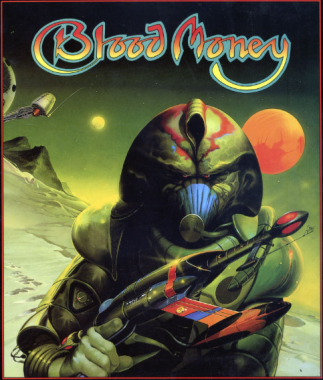
Overview
Blood Money forgoes any backstory or plot. There are no evil alien empires to overthrow, no hordes of invaders to repel and nobody to rescue. The game unashamedly refers to itself as an “alien safari” – a straight-up shooter with nothing to do except blast the hell out of screen after screen of exquisitely animated aliens.
The game comes on two disks, with disk one being entirely devoted to an elaborate intro, highlighting the Amiga’s graphical and audio capabilities. Psygnosis would become synonymous with titles that would push the technical envelope of Commodore’s wonder machine and Blood Money is a good example. A thumping dance beat kicks in as a small ship is seen flying through an asteroid field. It’s a stunning opening – rocks tumble towards the screen and fall away again as the audio track continues, featuring some terrific voice samples including UK comedian Harry Enfield’s character Loadsamoney (“Shut your mouth and look at my wad!!) and another sample of an unknown American newscaster (“The biggest unanswered question is where is the money”). On a side note, the latter sample also appeared on the intro to Earth, Wind & Fire’s System of Survival, released in 1983. Finally, a large blue planet drifts into view and the player is prompted to enter the second disk.
Once the second disk loads, the player is presented with a menu screen where they can choose a one or two player game. The option to turn off the music and just have sound effects during play is also present. An initial cash amount of $200 is available along with a choice of four planets to plunder. Actually, only the first two planets are accessible at the beginning since Planets Three and Four cost €300 and €400 respectively. But the player is free to choose either Planet One or Planet Two to begin with. Once either of these are completed (good luck with that), you should have amassed enough cash to choose either Planet Three or Four as your next conquest. Each planet has a different theme and places the player in an appropriate craft.
The $100-dollar Planet One puts the player in a helicopter in a futuristic, mechanoid landscape. As the level begins, the first thing to strike you is how slowly the screen begins to scroll. It’s positively sedate and your initial thoughts might be “This can’t be too difficult”. You would be wrong.
Before too long, the aliens arrive and while their attack patterns are mostly set and hence predictable, the game is punishingly hard. For a start, it demands pixel-perfect control of the player sprite. Both the ceiling and ground, as well as lots of scenery in between, must be avoided. Contact with anything will usually involve the almost immediate disappearance of the meagre shield your craft possesses (accompanied by a very demoralizing “whoosh” sound) and the loss of one of your three lives. The screen becomes full of bad guys and enemy fire pretty fast – a lot of the time, you end up watching in disbelief as your craft explodes for the umpteenth time, unaware of what actually hit you. As standard, the craft for all planets when starting out is a single horizontally-firing projectile. Trust us, before too long you’ll realize this will not be enough.
Thankfully the aliens release money when they expire (Blood Money, remember?), which you must fly over to collect. This creates an interesting balance to be achieved – do you play it safe and only kill what’s in your immediate path? Or do you risk losing a life to go after as many aliens as possible and amass a more sizeable booty? Whatever you decide, you’ll be relieved to see one of the equipment stores looming in the distance, not only for the chance to stock up on some much-needed weaponry but also for the opportunity to take a breather and give your shredded nerves a chance to recover.
The equipment stores contain some vital (and we really do mean VITAL) kit to make things a bit easier out there. An absolute must are the aerial and ground missile add-ons which can be purchased to accompany your default horizontal firing missiles. These greatly increase your firepower and range, as well as make it easier to deal with the ubiquitous (and very annoying) gun emplacements which dot the ceilings and ground sections of all four planets in Blood Money. You really won’t get very far without these two power-ups and at €100 for each, they won’t break the bank.
Another highly useful add-on is the long range missile. By default, your missiles only extend about half way across the screen before disappearing. The long range power-up will enable your missiles to travel the full span of the screen. This is invaluable for taking out enemies who are starting to appear at the edge of the screen, before they come closer and start causing problems.
Other helpful add-ons include a bomb which falls vertically from your craft alongside your standard missiles and a rear-firing missile. Extra lives can also be purchased, though at €250, they ain’t cheap.
Once you’re fully stocked up, life gets a little easier. Until you smash into something or take a hit from an alien projectile that is, and lose one of your precious lives. While you reappear immediately where you died, you’re stripped of all of your power-ups which means you have to do battle with the standard pea-shooter until you amass enough cash to stock up again. That’s assuming you make it to the next equipment store of course. High on our list of the most frustrating gaming experiences ever is the following scenario: you battle successfully through part of a Blood Money planet, collecting enough cash to get your craft properly equipped for alien bashing. An equipment store looms in the distance, an oasis of calm and life-preserving gear in the midst of all the chaos. You carefully pilot your way in, kit your craft out with everything you need (or can afford), take a deep breath and head back out into the carnage; only to stuff up the exit and fly directly into the scenery or the path of an enemy bullet. Boom. One life gone, along with all your hard-earned cash which you just blew on equipment that you lost when you cheerfully glided into a wall.
Battle your way to the end of the level and you’ll face the classic guardian. In Planet One, this is a large spaceship which moves in a set pattern around the screen, firing multiple weapons at you. On Planet Two, there are three guardians which appear in turn. Believe it or not, the guardians are the easiest part of Blood Money. As long as you’re careful with your movements and learn the pattern of each guardian, none of them should cause you too much trouble. Once the guardian(s) have been defeated at the end of a level, the player is given a bonus based on the amount of cash they already have. You’re then free to choose any of the three remaining planets to conquer next, which is a nice touch instead of forcing you to progress in a set order.
Planet Two places the player in a submarine in an underwater level; while the carnage is the same, the style of aliens is mostly different from Planet One (with the exception of the gun turrets, though these take on different guises on different planets). Planet Three takes place in an ice-covered world with the player looking very exposed as they putter along in a jet-pack. The final level takes places in a non-descript spaceship on a planet that seems to resemble the inside of a giant volcano. We have witnessed grown men weep on this level.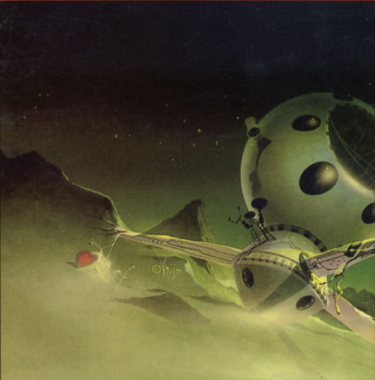
Graphics and audio
Blood Money looks marvellous. The Amiga’s color palette is employed to great effect with all 32 on-screen available colors used. This results in a bright, almost cartoon-like appearance which really catches the eye. The explosion animations used when the aliens bite the dust are splendid, with lots of orange and red used to really sell the impact, though you might find the animation of your own craft exploding yet again to be less than captivating to watch.
The animations used for many of the aliens are also a joy. Clearly a lot of thought and effort went into creating a different style of enemy for each planet. We particularly like the giant jellyfish and scuttling scorpions on the underwater planet. As mentioned, common to all planets are ground and ceiling gun emplacements, which in a nice graphical touch look different on each planet, e.g. they’re dome-shaped gun turrets on Planet One and fish heads on Planet Two. (These guys are also a major pain in the ass and need taking out as soon as they scroll into view).
As mentioned, the player has a choice of selecting either music or sound effects for the in-game sound. The same music track, written by Ray Norrish, is used for each planet, as well as the menu screen. While this was probably done to save memory and disk space, it can start to grate after a while. It’s also an unusual style of music for a frantic shoot-‘em-up – very slow and plodding, almost funereal in fact, which is probably fitting since the player ends up dying so often.
At any event, the player can also choose to just have sound effects while playing. The Amiga’s sound chip is used to good effect here. While the player’s craft for all four planets is silent, the explosions and projectiles firing are perfect – deep, throaty roars which sounded great on our Philips stereo monitor. There’s a very satisfying ping! sound effect too as you collect your hard-earned cash from exploding aliens.
We should also mention again that that whoosh! sound effect which accompanies your shields being depleted, after you fly into the ceiling for the 857th time. The screen gets so busy and there are so many projectiles and bad guys flying around, that often it’s this sound which alerts you to the fact that you’ve just had a close call, or are flying to close to the scenery and need to take evasive action. For this reason alone, it’s a good idea to have sound effects enabled for play as opposed to the music track.
Conclusion
You may have noticed us harping on quite a bit about Blood Money’s difficulty during this review. That’s because, for our money (aha!), it’s one of the toughest and most frustrating shooters ever to grace the Amiga.
Lethal scenery, cramped flying quarters, tons of aliens, those fricking gun turrets and pixel-perfect positioning means your skills will be sorely tested. Add in the fact that you’re stripped of all power-ups when you lose a life and that equipment stores are often put in very tight spots, and you have one hell of a challenge on your hands. And yet… for all that, Blood Money remains highly addictive and, damn it, fun. There’s something undeniably satisfying about learning the alien attack patterns and adopting a strategy to make it through the mayhem. And seeing the word PLUNDERED written across a planet you’ve just conquered on the level selection screen is very rewarding.
It also represents a real effort by developers to push the Amiga and show what the machine could do when programmed by people who really understood the hardware. Many Amiga games in the mid-to-late 80’s were often ports of existing Atari ST titles. To save time and money, developers would sometimes opt to not re-write a title to take advantage of the Amiga’s superior graphics and audio hardware, resulting in many Amiga games which betrayed their ST roots. Blood Money, like many other Psygnosis titles, became a call-to-arms for Amiga developers to showcase the platform’s potential as a home machine offering arcade-quality gaming experiences. For all its flaws, Blood Money remains a fascinating and important entry in the pantheon of Amiga games.